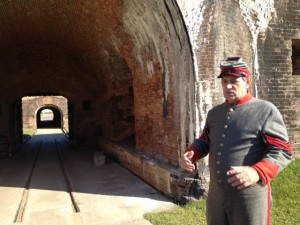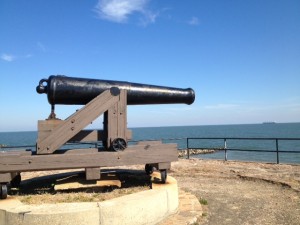
A military docent explains the wartime efforts at Fort Morgan.
Two of the most legendary landmarks of the area, Fort Morgan and Fort Gaines, stand as testaments to the military battles during the closing years of the Civil War. Both forts played an integral role in the Battle of Mobile Bay, an engagement of the American Civil War that pitted Union fleet commander Admiral David G. Farragut against Confederate leader Admiral Franklin Buchanan in a fiery attempt to run the gauntlet ”” endure an attack between both forts. The passage was enforced with guns, torpedoes (known as mines) and other obstructions. While attempting the run, the Navy warship the U.S.S. Tecumseh, struck a mine and sank in a matter of seconds, throwing the Union fleet into a state of panic. Admiral Farragut, in the heat of battle, yelled: “Damn the torpedoes! Full speed ahead.” The Navy ultimately forged ahead and defeated the Confederate squadron in the bay, causing the inevitable surrender of the outer forts.
Fort Morgan is a massive and impressive star-shaped structure named after Revolutionary War hero General Daniel Morgan. Built after the War of 1812 as a means to fortify the eastern and southern coastlines against enemy attack, the fort was designed with extensive land defenses to enable it to withstand a siege and crafted with 40 million bricks, hailed at the time as the most impressive example of military architecture. The five remaining wooden buildings on site date back to the beginning of the 20th century; the oldest building on site is the lighthouse keeper’s house built in 1872. Some of the more picturesque spots of Fort Morgan include the panoramic view from atop Panama Mount, the circular gun mount used to facilitate the manipulation of 155-millimeter guns, as well as the battery duportail, the concrete gun emplacement that mounted two 12-inch breech-loading cannons called disappearing rifles.

A cannon stands guard atop a bastion at Fort Gaines.
Fort Gaines, situated on Dauphin Island, was named for Edmund Pendleton Gaines, a U.S. Army officer who served during the War of 1812, and is considered to be one of the nation’s best-preserved Civil War era masonry forts. The fortification of Fort Gaines was established in 1821 but not completed until 1861. The Alabama Militia seized control of the fort at the start of the Civil War and made improvements to the structure in 1862. The fort still has the original cannons used in battle and features several pre-Civil War brick buildings in the interior courtyard, tunnel systems to the fortified corner bastions and a small museum detailing the uniforms, ammunition and hand-written letters of soldiers to their families during the war. The intricate brickwork of the structure, all built without keystones, is an impressive example of the detailed knowledge of symmetry and architecture of the fort’s original craftsmen. However, due to years of storms and severe erosion along the Gulf of Mexico, the historic landmark is now in danger of being washed away.



Leave a Reply